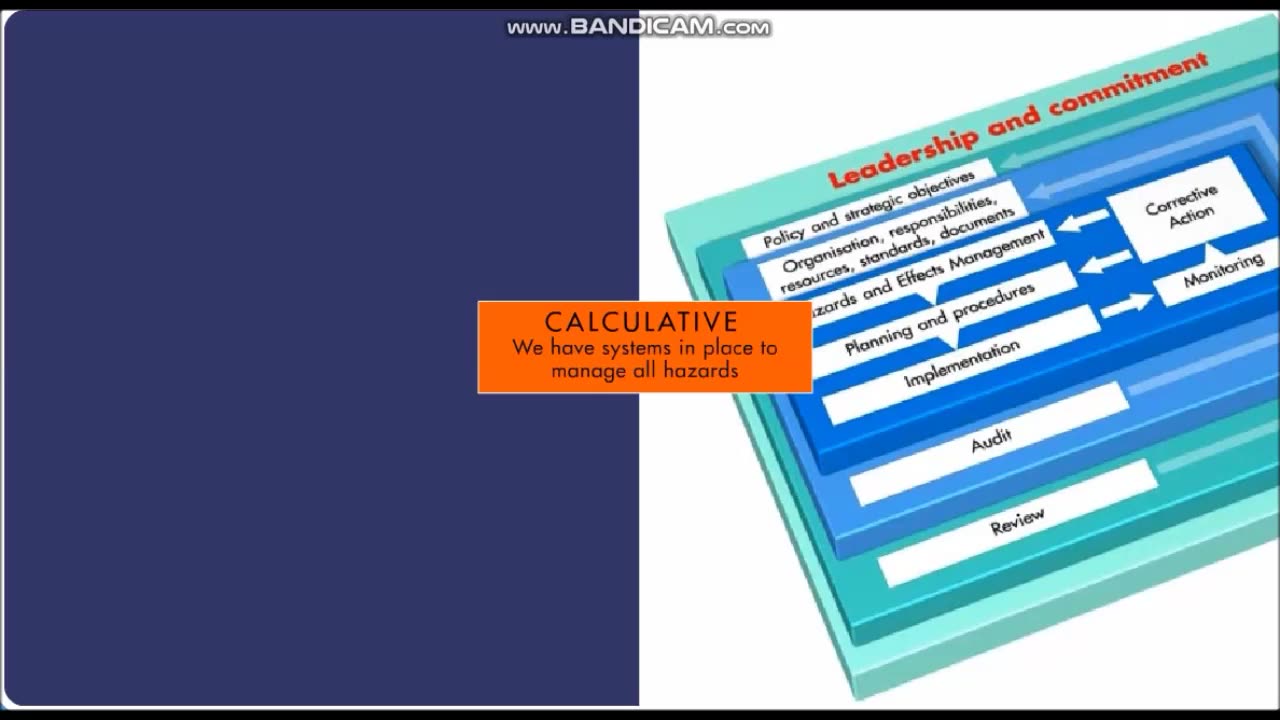Premium Only Content

Safety Culture Ladder avi
The **Safety Culture Ladder (SCL)** is a framework designed to assess, develop, and enhance the safety culture within organizations. It provides a structured approach to evaluating how safety is embedded in company practices, attitudes, and behaviors. Originally developed by ProRail in the Netherlands, it is now widely adopted across industries to encourage continuous improvement in safety performance.
---
### **Goals of the Safety Culture Ladder**
- Promote proactive and positive safety behaviors.
- Encourage employees at all levels to prioritize safety.
- Measure and improve safety awareness and practices over time.
---
### **Structure of the Safety Culture Ladder**
The Safety Culture Ladder consists of **five levels** that describe an organization’s maturity in safety culture. Each level indicates the extent to which safety is integrated into daily operations and decision-making.
#### **Level 1: Pathological**
- **Characteristics**: Safety is not a priority; reactive approach to accidents.
- **Behaviors**: Only comply with regulations to avoid penalties; minimal effort to improve safety.
#### **Level 2: Reactive**
- **Characteristics**: Safety measures are implemented after incidents occur.
- **Behaviors**: Focus on fixing problems rather than preventing them; blame culture may exist.
#### **Level 3: Calculative**
- **Characteristics**: Safety is managed systematically with procedures and protocols.
- **Behaviors**: Emphasis on compliance and control; reliance on rules to maintain safety.
#### **Level 4: Proactive**
- **Characteristics**: Safety is seen as a core value and integrated into all aspects of operations.
- **Behaviors**: Employees anticipate risks and act to prevent incidents; open communication about safety.
#### **Level 5: Generative**
- **Characteristics**: Safety is embedded in the organizational DNA; it drives innovation and excellence.
- **Behaviors**: Everyone takes responsibility for safety; continuous learning and improvement are prioritized.
---
### **Assessment and Certification**
Organizations can undergo audits to determine their current level on the Safety Culture Ladder. Certification helps:
- Demonstrate commitment to safety.
- Benchmark progress against industry standards.
- Build trust with clients, employees, and stakeholders.
---
### **Benefits of the Safety Culture Ladder**
1. **Improved Safety Outcomes**
- Reduction in workplace accidents and near-misses.
2. **Enhanced Employee Engagement**
- Employees feel valued and empowered to contribute to safety initiatives.
3. **Compliance with Regulations**
- Alignment with legal and industry safety standards.
4. **Competitive Advantage**
- Demonstrates leadership in safety practices, which can attract business and talent.
5. **Sustainable Safety Practices**
- Encourages long-term commitment to safety rather than short-term fixes.
---
### **Implementation Steps**
1. **Initial Assessment**: Determine the current safety culture level using surveys, interviews, and incident data.
2. **Action Plan**: Develop strategies to address gaps and promote safety behaviors.
3. **Employee Involvement**: Engage staff at all levels in creating a safety-focused environment.
4. **Monitoring and Review**: Continuously evaluate progress and refine safety practices.
5. **Certification**: Seek third-party validation to benchmark and validate progress.
Would you like guidance on applying the Safety Culture Ladder in your organization or resources for its implementation?
-
 6:43
6:43
HSESafetyInformation
1 month agoLahori Chanay Recipe - Lahori Cholay Recipe - Chana Chana Masala
38 -
 15:53
15:53
Producer Michael
13 hours agoWHY I MOVED TO LAS VEGAS! (CALIFORNIA IS DOOMED)
79.8K12 -
 9:05:08
9:05:08
Dabkillah
14 hours ago🔴LIVE-DABKILLAH-For The BEST CHAT and ok gaming lol
67.9K1 -
 4:15:17
4:15:17
Foaly's Pub
10 hours ago $4.38 earnedFOALY'S PUB GAME DEN #768(HALO INFINITE #175)
50.8K1 -
 1:31:31
1:31:31
Adam Does Movies
15 hours ago $3.28 earnedHanging Out, Talking Movies + YouTube Silver Play Button Unboxing! - LIVE!
53.7K4 -
 1:22:50
1:22:50
Glenn Greenwald
12 hours agoRight-Wing Populists Barred from Running in Democratic World; JFK Reporter Jeff Morley on CIA Involvement and his Testimony in Congress Today | SYSTEM UPDATE #432
144K61 -
 1:56:28
1:56:28
Anthony Rogers
5 days agoEpisode 359 - The Dark Side of Disney
25.9K1 -
 58:27
58:27
BonginoReport
12 hours agoMusk’s 13th Alleged Baby Mama’s Anti-Privacy Tour - Nightly Scroll w/Hayley Caronia (Ep.17)
166K88 -
 2:11:32
2:11:32
Michael Franzese
11 hours agoLindy Li: DNC Insider Reveals Dark Truth About Biden, Kamala and Pelosi
70K70 -
 1:17:20
1:17:20
Kim Iversen
13 hours agoFrom Tesla-Smashing to Jasmine Crockett-Stanning: Woke Unhinged Edition
132K91